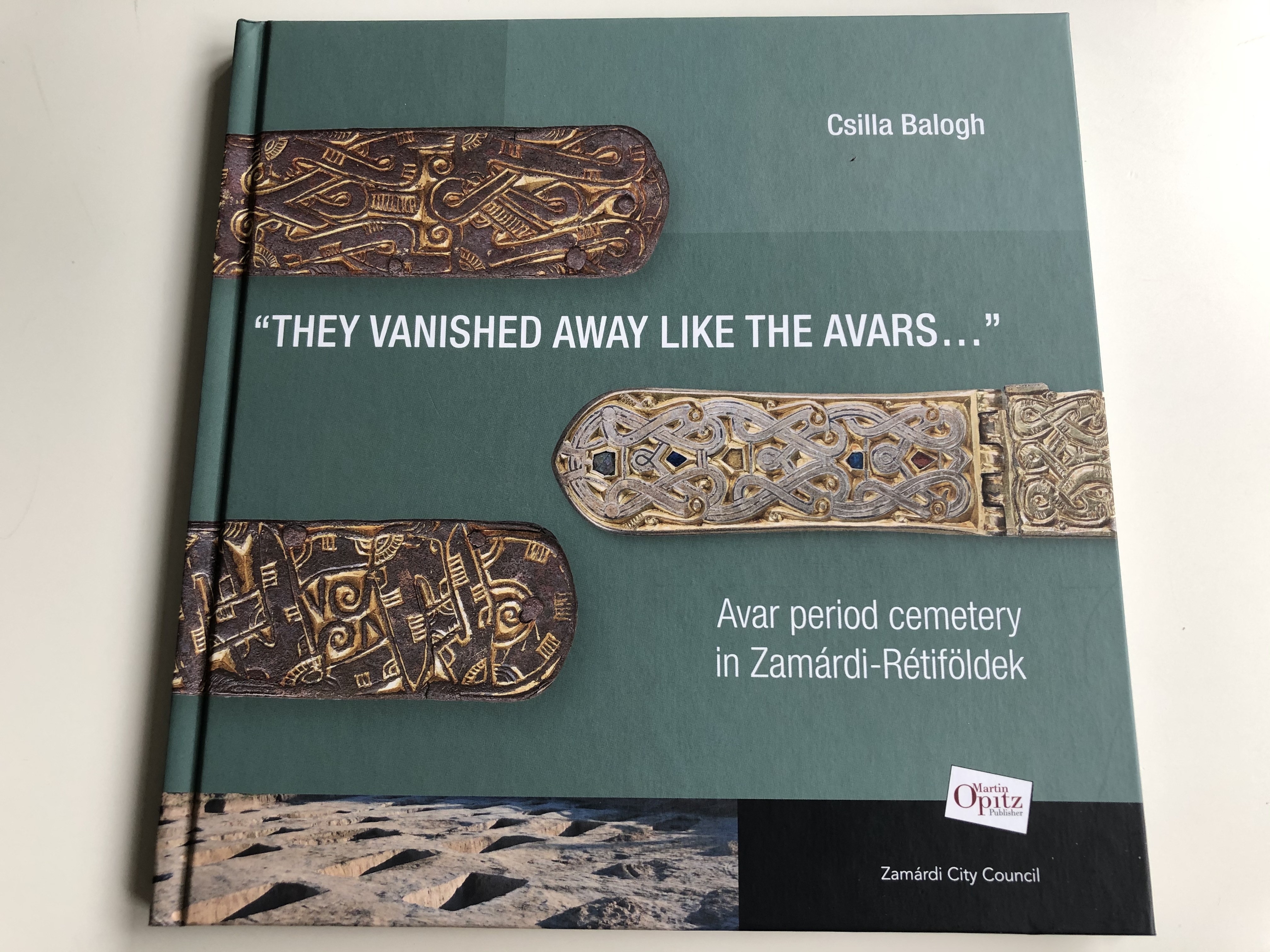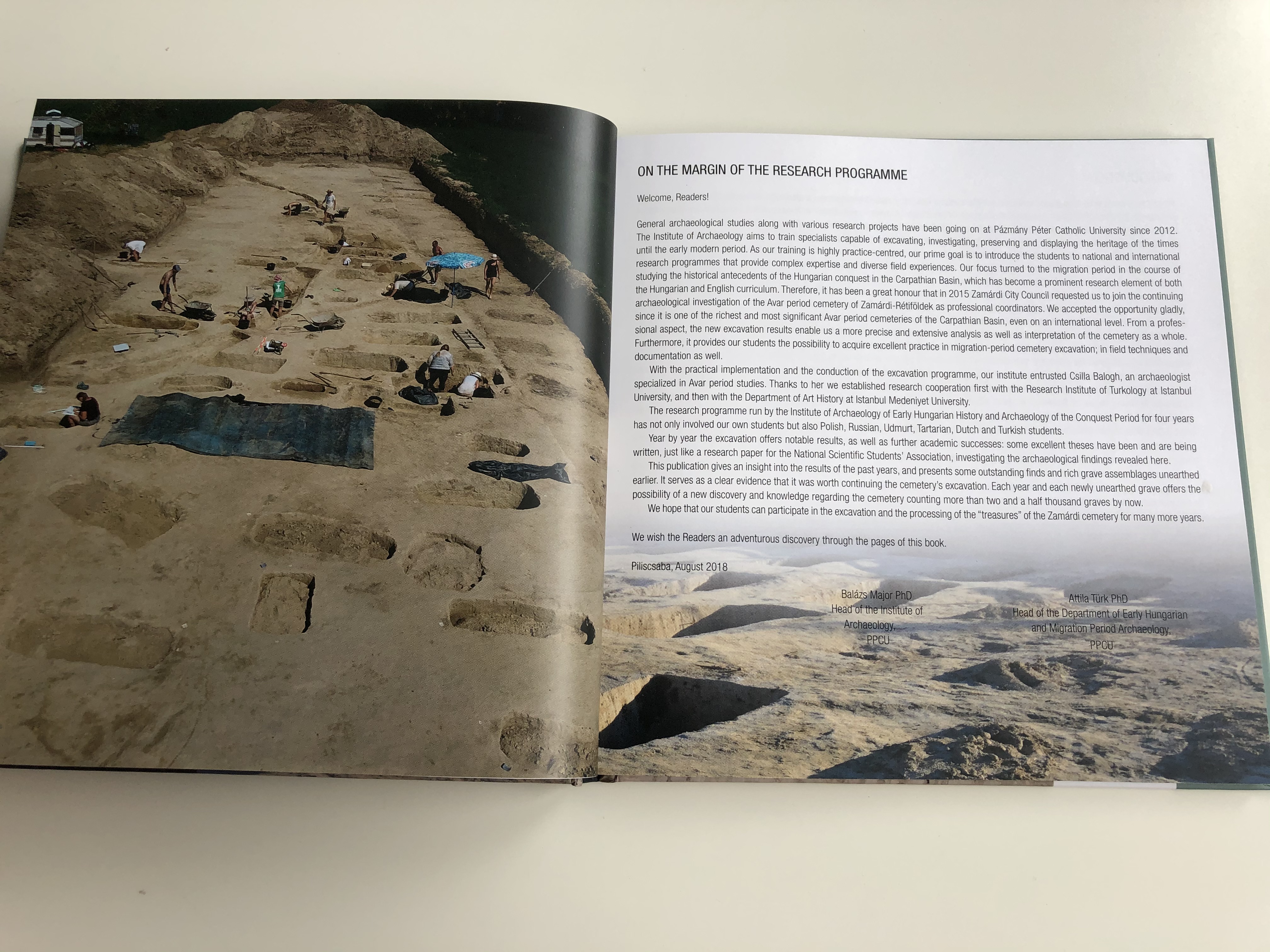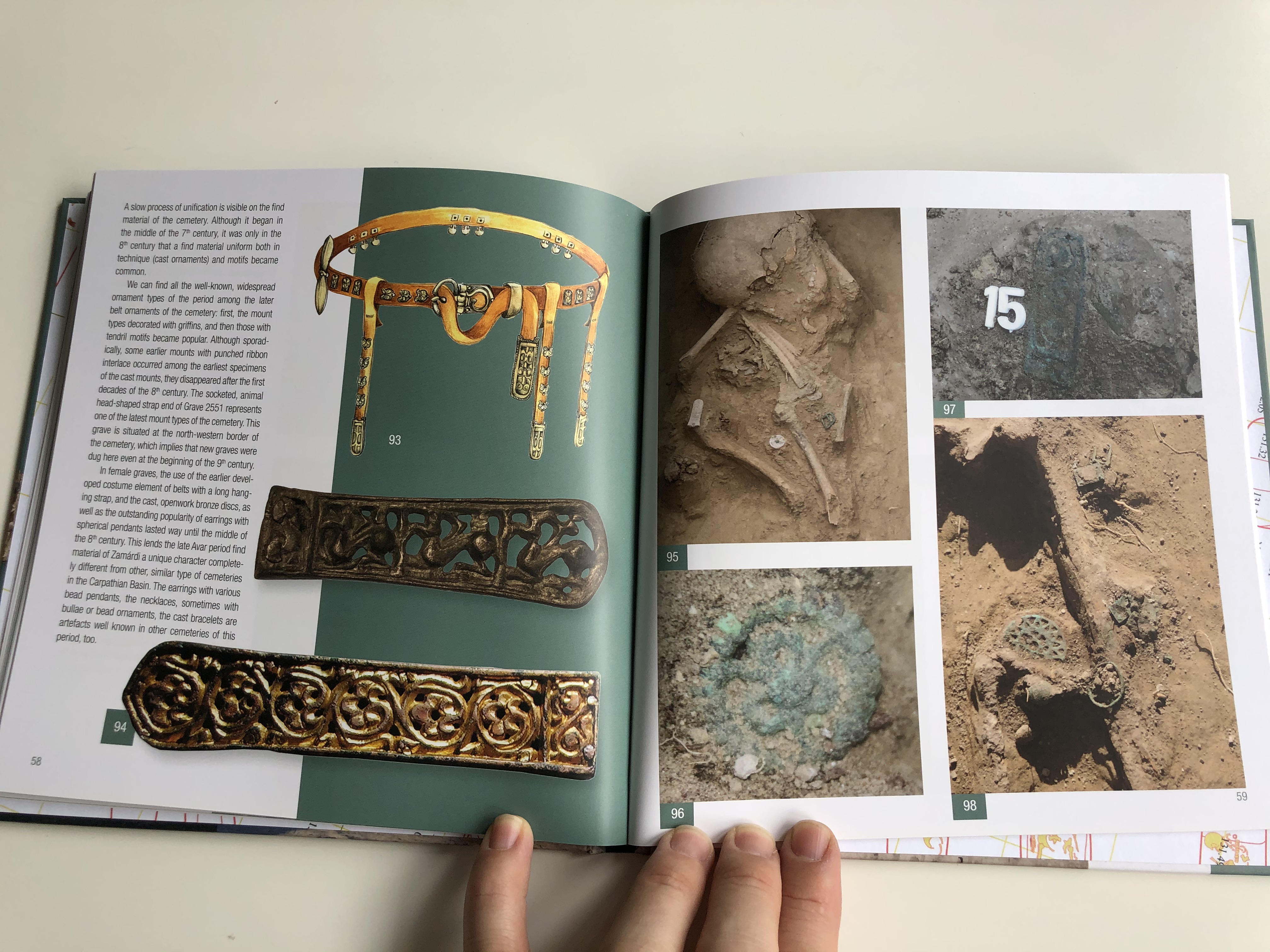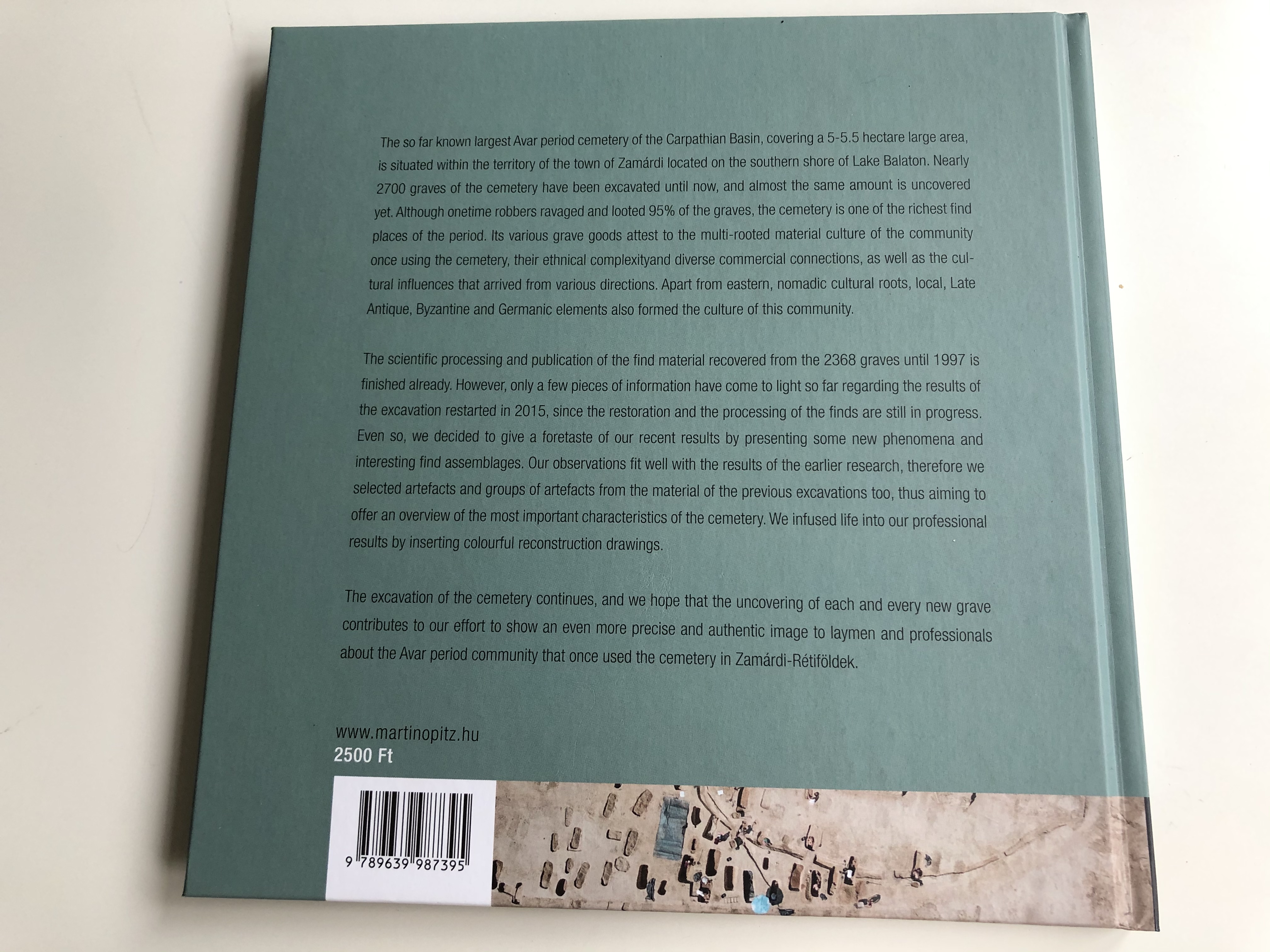"They Vanished Away like the Avars" by Csilla Balogh
Avar Period Cemetery in Zamárdi Rétiföldek
Translated by Zsófia Kondé
Overview | Áttekintés
"They Vanished Away like the Avars" is a fascinating exploration of an Avar period cemetery located in Zamárdi Rétiföldek, presented in a beautifully translated work by Zsófia Kondé. The book delves into the archaeological findings and historical context surrounding the cemetery, providing insight into the Avar culture and their significant impact on the region. With 72 pages, this hardcover edition is a perfect blend of historical research and storytelling, accessible to both scholars and general readers with an interest in Hungarian history and archaeology. Published by Zamárdi City Council and Martin Opitz, the book offers a well-rounded perspective on the subject.
"They Vanished Away like the Avars" a Zsófia Kondé által lefordított lenyűgöző kutatás az Avar korszak temetőjéről a Zamárdi Rétiföldek területén. A könyv az archeológiai leletek és a temető körüli történelmi összefüggések mélyebb megértését kínálja, betekintést nyújtva az avar kultúrába és annak jelentős hatásába a régióra. A 72 oldalas keménytáblás kiadás tökéletes keveréke a történelmi kutatásnak és a történetmesélésnek, és ideális választás mind a tudósok, mind a történelmi és régészeti érdekű olvasók számára. A Zamárdi Városi Önkormányzat és a Martin Opitz kiadásában megjelent könyv átfogó képet nyújt a témáról.
Product Features | Termék Jellemzői
-
Format: Hardcover
-
Pages: 72
-
Language: English
-
Publisher: Zamárdi City Council / Martin Opitz
-
ISBN: 9789639987395 / 978-9639987395
-
ISBN-10: 9639987395
-
Kötés: Tvrdi borító
-
Oldalszám: 72
-
Nyelv: Angol
-
Kiadó: Zamárdi Városi Önkormányzat / Martin Opitz
-
ISBN: 9789639987395 / 978-9639987395
-
ISBN-10: 9639987395
About the Author | A Szerzőről
Csilla Balogh is a Hungarian historian and archaeologist who has dedicated much of her work to studying the Avar period in Hungary. Her research focuses on archaeological sites, cultural histories, and the legacy of the Avars in the Carpathian Basin. She has contributed significantly to the understanding of the Avar culture through excavations, publications, and scholarly work.
Csilla Balogh magyar történész és régész, aki munkájának jelentős részét az avar korszak kutatására szentelte Magyarországon. Kutatásai az archeológiai lelőhelyekre, a kulturális történetekre és az avarok örökségére összpontosítanak a Kárpát-medencében. Jelentős mértékben hozzájárult az avar kultúra megértéséhez ásatások, publikációk és tudományos munkák révén.
Interesting Facts | Érdekes Tények
-
The book offers a unique perspective on the Avar period, a time in Hungarian history marked by the Avars’ settlement and their influence on the region.
-
The Zamárdi Rétiföldek cemetery is a key archaeological site, offering invaluable insights into the burial customs and daily lives of the Avar people.
-
This work is an important contribution to Hungarian archaeology, shedding light on a period of history that has often been overlooked.
-
A könyv egyedülálló betekintést nyújt az Avar korszakba, egy olyan időszakba, amelyet az avarok letelepedése és hatásuk jellemeztek a régióban.
-
A Zamárdi Rétiföldek temető kulcsfontosságú régészeti lelőhely, amely felbecsülhetetlen betekintést ad az avarok temetkezési szokásaiba és mindennapi életébe.
-
Ez a munka fontos hozzájárulás a magyar régészethez, fényt derítve egy olyan történelmi időszakra, amely gyakran elhanyagolt maradt.
Hashtags
#AvarPeriod #HungarianHistory #Archaeology #Zamárdi #HistoricalResearch #CsillaBalogh #EnglishTranslation #AncientCultures #HungarianArchaeology #HistoricalBooks
ON THE MARGIN OF THE RESEARCH PROGRAMME:
Welcome, Readers!
General archaeological studies along with various research projects have been going on at Pázmány Péter Catholic University since 2012.
The Institute of Archaeology aims to train specialists capable of excavating, investigating, preserving and displaying the heritage of the times
until the early modern period. As our training is highly practice-centred, our prime goal is to introduce the students to national and international
research programmes that provide complex expertise and diverse field experiences. Our focus turned to the migration period in the course of
studying the historical antecedents of the Hungarian conquest in the Carpathian Basin, which has become a prominent research element of both
the Hungarian and English curriculum. Therefore, it has been a great honour that in 2015 Zamárdi City Council requested us to join the continuing
archaeological investigation of the Avar period cemetery of Zamárdi-Rétiföldek as professional coordinators. We accepted the opportunity gladly,
since it is one of the richest and most significant Avar period cemeteries of the Carpathian Basin, even on an international level. From a profes-
sional aspect, the new excavation results enable us a more precise and extensive analysis as well as interpretation of the cemetery as a whole.
Furthermore, it provides our students the possibility to acquire excellent practice in migration-period cemetery excavation; in field techniques and
documentation as well.
With the practical implementation and the conduction of the excavation programme, our institute entrusted Csilla Balogh, an archaeologist
specialized in Avar period studies. Thanks to her we established research cooperation first with the Research Institute of Turkology at Istanbul
University, and then with the Department of Art History at Istanbul Medeniyet University.
The research programme run by the Institute of Archaeology of Early Hungarian History and Archaeology of the Conquest Period for four years
has not only involved our own students but also Polish, Russian, Udmurt, Tartarian, Dutch and Turkish students.
Year by year the excavation offers notable results, as well as further academic successes: some excellent theses have been and are being
written, just like a research paper for the National Scientific Students’ Association, investigating the archaeological findings revealed here.
This publication gives an insight into the results of the past years, and presents some outstanding finds and rich grave assemblages unearthed
earlier. It serves as a clear evidence that it was worth continuing the cemetery’s excavation. Each year and each newly unearthed grave offers the
possibility of a new discovery and knowledge regarding the cemetery counting more than two and a half thousand graves by now.
We hope that our students can participate in the excavation and the processing of the “treasures” of the Zamárdi cemetery for many more years.
We wish the Readers an adventurous discovery through the pages of this book.
Piliscsaba, August 2018
INTRODUCTION
In 2015, the Institute of Archaeology of Pázmány Péter Catholic University asked me to join the archaeological investigation of the Avar period
cemetery of Zamárdi-Rétiföldek – restarting after a pause of more than 15 years – as conductor of the excavation. Hungarian and international
research had long known a number of prime finds of the Zamárdi cemetery from various exhibition catalogues, just like the material of the 2368
graves uncovered until 1998 and published by Edith Bárdos and Éva Garam in Volumes 9 and 10 of Monumenta Avarorum Archaeologica (2009,
2014). Unfortunately, the analysis of the finds had to be put on hold then. Even so, for those who studied this period, the ethnical and cultural
diversity of the community using the cemetery, as well as the outstanding significance of this site among the nearly three and a half thousand
Avar period burial places of the Carpathian Basin was obvious.
The opinion of Hungarian researchers varied on whether it was worth and necessary to continue the excavation of the cemetery, in which they
had already known more graves than in other large cemeteries. I, personally, had no doubt about the continuation of the cemetery excavation,
and the inherent opportunities and professional outcomes. We knew by the evidence of the narrow research trench opened north and south of
the cemetery section uncovered by Edith Bárdos, aiming to detect its extension, that besides the 2368 burials excavated until 1998 the cemetery
probably contained nearly the same amount of graves yet. Moreover, the discovery of every new grave is a step further towards a more detailed
and precise knowledge on the graveyard as a whole.
In addition to professional aspects and interests in a narrow sense, another apropos of this research excavation was to provide practice field
for students of archaeology for acquiring methods of Migration period cemetery excavations. I believe the past four seasons of excavation were
successful in several respects. Dozens of students have participated, acquired skills in excavating graves, and learned the various phases of
recording. Furthermore, the interest of some students who became acquainted with the Migration period in Zamárdi turned towards the research
of the Avar period, resulting in university theses and a research paper for the National Scientific Students’ Association.
Year by year, the interest of people from the neighbourhood is growing towards the results of the excavation, and a number of new phenomena
have come to light that might even be a novelty for professionals. Therefore, we decided to publish the first results by presenting the most inter-
esting observations, details, and new phenomena, even though the restoration and scientific processing of the material of the 332 features having
been revealed on a nearly 3000 m2 area from 2008 are still in progress. In most cases, these results supplement Éva Garam’s analyses written
on the material of former excavations, and published meanwhile in Volume 12 of Monumenta Avarorum Archaeologica (2018).
Our goal is therefore a preliminary report; however, as our research is an organic continuation of the earlier, nearly two decades of excava-
tions, and our results complete the results of those, we thought that our publication would be kind of a torso without presenting the earlier finds.
This is the reason why we decided to create a small volume that aims to provide an insight into the cemetery as a whole, by presenting some
exciting burial practices, special finds and find assemblages, while touching upon both previously and newly unearthed materials. Obviously, it is
not possible to provide an overall, comprehensive view of the cemetery within the framework of this booklet. We have thus sought an approach
that reveals the few artefacts and phenomena selected from the culturally complex, abundant material of the cemetery in a way that brings people
once living here to life. Beside the field photographs and pictures of the finds, we present reconstructions of the original artefacts and costumes
that “narrate” the onetime way of use of the archaeological finds and clothing elements in pictures. Fruzsina Pápai, former student of the Institute
of Archaeology at Pázmány Péter Catholic University shaped the reconstructions striving for professional authenticity into artistic illustrations; she
formed the information revealed by scientific methods into scenes, movements, and feelings between the characters.
I hope that if citizens of Zamárdi leaf through the pages of this book, they will be even prouder of their city, and that nearby residents and
“wanderers” arriving from afar will be even more interested in this little town on the shore of Lake Balaton. I also hope that it will convince sceptical
archaeologists that it is indeed worth continuing to research the cemetery, as each and every grave includes the possibility of a new discovery.
Special thanks go to mayor Gyula Csákovics who helped turning our friendly conversation into a decision, and created the necessary financial
conditions. We also owe thanks to the City Council of Zamárdi for funding the excavation year after year. In the last years, many of our colleagues
participated in the project for a longer or shorter period: archaeologists Tamás Czuppon, Bence Gulyás and Géza Szabó, anthropologists Antónia
Marcsik, Erika Molnár and Olga Spekker, and archaeozoologist Éva Ágnes Nyerges. I am indebted to them for their selfless assistance. From 2015,
the archaeological objects – often in very poor condition – have been in great care in the hands of Bernadett Dobó, Márta Borbíró and Teréz
Vidovics, who reveal their beauty from under the thick corrosion or dried layer of dirt, and restore their original glow. Here, again, I would like to
express my gratitude for their careful work. Our research is not a one-person success but the hard and persistent work of many students. I hope
that they will take part in this “adventure” for many more years.
Zamárdi, August 2018























































